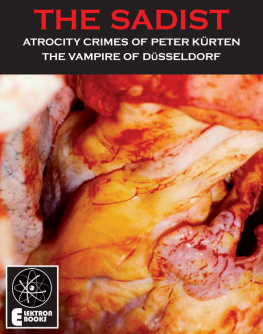FOREWORD
In the whole history of crime there is to be found no record comparable in circumstances of frightfulness with the long series of crimes perpetrated in our own time by the Dsseldorf murderer, Peter Krten.
The epidemic of sexual outrages and murders which took place in the town of Dsseldorf between the months of February and November in the year 1929, caused a wave of horror and indignation to sweep, not only through Dsseldorf, but through all Germany and, it may be said without exaggeration, throughout the whole world.
As one outrage succeeded another and always in circumstances of grim drama; as one type of crime was followed by yet another, public consternation reached the point of stupefaction.
Krten, however, has been judged; he now belongs to criminal history.
Krtens crimes were not merely the subject of exhaustive judicial examination; justice went deeper in his case and sought to probe the soul of this strange and enigmatic man.
In so doing Justice has placed us in a position to understand the nature both of the crimes and of the perpetrator of them. Here, for the medico-jurist, is truly absorbing material for study, for Krten is a clinical subject who yields, in exchange for a careful analysis, a real enlargement of our knowledge of the abnormal operating in the sphere of crime.
I have arranged the extensive material in the following pages in the following way. I shall first deal with and describe, from the medico-legal standpoint, the events which took place in Dsseldorf in 1929. I shall then proceed to deal with the crimes as they were described to me by the criminal himself, and, last, I shall attempt an analytical estimate of the criminal and the nature of his crimes in the light of our knowledge of sadism.
I propose first to describe the state of affairs disclosed by my investigations, later I shall offer an interpretation of them in the light of knowledge later acquired of the perpetrator.
CHAPTER I
THE DSSELDORF ATROCITIES, 1929
THE THREE FEBRUARY CASES
CASE 37. FRAU KHN
At 9pm on the 3rd of February, 1929, Frau Khn was waylaid at dusk on a lonely road in the Flingern district. The man overtook her, bid her Good evening. He gripped her by the lapels of her coat with the words: No row!
Dont scream! With the other hand he stabbed her. The woman fell back and screamed for help. The criminal made off.
I found in the case of Frau Khn twenty-four flesh wounds on the head, the trunk, and the arms. The victim said that the criminal had stabbed her in rapid succession.
CASE 38. RUDOLF SCHEER
In the case of the third victim there were the same numerous stabs, characteristic of the same criminal. Only five days after the murder of Rosa Ohliger there was found on the Hellweg, on the outskirts of the town, and once again in the Flingern district, the body of a man, by name Scheer, of about forty-five years of age. He had sustained twenty knife wounds, of which sixteen were over a small area of the neck. Except for one stab, all were horizontal. Only one stab in the neck and three in the back were vertical.
Three stabs had proved fatal: a stab in the temple had caused severe haemorrhage into the brain cavity, the stab in the neck had caused bleeding into the spinal cord, and the stab in the back had resulted in a pneumo-thorax.
From the absence of defensive wounds, and from the distribution of the stabs, I drew the conclusion that the criminal had attacked his victim from behind and stabbed him.
Scheer had left a beer-house in the evening in a drunken state. He must have been attacked between 11 oclock and midnight, but not until the next morning about 8 oclock was the body found. Despite a temperature of 62F the body was still warm, rigor mortis just setting in. The combination of stabs, alcohol and low temperature explains the slow death.
CASE 39. CHILD ROSA OHLIGER
On the 9th of February, 1929, about 9 oclock in the morning, workmen going to work found in the vicinity of the building upon which they were employed in the Kettwigerstrasse, in the Flingern district, the body of an eight-year-old girl lying under a hedge. The ground at that point sloped slightly towards the hedge, and as the hedge faced a wide open space, it was only by chance that the body was discovered.
The body was completely clothed and clad in a cloak. The clothing, however, was partially burnt and the underclothing still smouldered. The body, which smelled strongly of petroleum, was not in any sort of disorder, for even the openings of the dress and the knickers were not disarranged. A closer examination of the clothing revealed bloodstains from multiple wounds in the breast, wounds made, quite obviously, through the clothing. On the inner part of the knickers near the external genitalia were two small bloodstains.
Microscopic examination revealed the presence hereabouts of seminal fluid.
In the vagina there was fluid blood which had flowed from a wound 10mm in length, at the entrance of the vaginal cavity.
The autopsy showed that the burning had affected practically only the clothing, injuring the skin surface nowhere but on the upper part of the thighs, the neck and chin, over which area the skin was blackened and discoloured, while the hair of the head was a black, charred mass, here and there completely burnt off. On the left breast there was a group of thirteen wounds, the face was bloated and livid. The stabs about the left breast were grouped over an area rather smaller than a hand. Five of the wounds had penetrated the heart, three had pierced the left and right pleurae; three had penetrated the liver. In the pleural cavities I found 750cc of blood. Death must have been swift through internal haemorrhage. The scene of the crime was without trace of blood. The criminal had attempted to burn the clothing of the body only. There were no traces to suggest that soot had been inhaled, and the burning was without vital reaction. In the tissues of the lumbar region there was some 40mm of blood infiltration.
In the stomach was found a mass of chyme, partially digested white cabbage, and remains of meat.
The essential factors to be considered, from the medico-legal standpoint, for a diagnosis of the cause of death and for a theory as to the time of it, as well as for the motive of the murderer, were the characteristic stabs, the congestion of blood which was found in the head, the exact nature of the wounds and the condition of the contents of the stomach, and, last, the injury to the genitalia. So far as the congestion of blood in the head is concerned, one can only suggest that it indicated a forcible strangulation.
The judicial autopsy of the Ohliger child established the time of death, the contents of the stomach assisting to that end.
Death must have occurred very quickly through the heart wounds.
There were no visible marks where the strangling grip had been applied, but some manner of strangulation must have initiated the attack though leaving no traces on the skin of the neck. No calls for help were heard in the rather populous neighbourhood where the crime was committed.
The mother deposed that the murdered child had eaten sauerkraut about 2pm and had then set out to visit a friend. At 6 oclock the friend had advised the child to hurry home before dark. There was a public footpath which she could take and which offered her a short cut.
Bearing in mind the fact that in six hours the stomach could normally complete the work of digestion, then the scarcely digested food found in the stomach indicates that death took place between 6 and 7 oclock in the evening. The autopsy indicated that the child had been waylaid while on her homeward way.
The condition of the genitals revealed an injury of little consequence on the mucous membrane of the vagina. The hymen was torn about 10mm.










